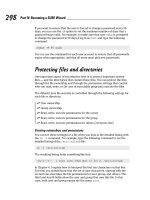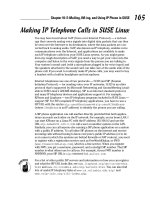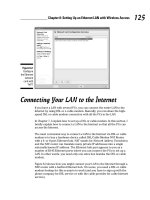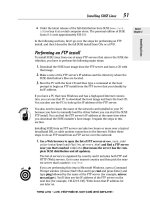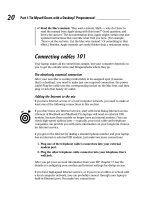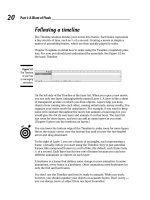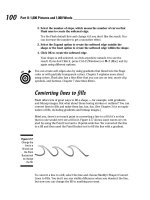Oracle PL/SQL for dummies phần 2 ppt
Bạn đang xem bản rút gọn của tài liệu. Xem và tải ngay bản đầy đủ của tài liệu tại đây (979.72 KB, 44 trang )
via TCP/IP, don’t block it. This issue arose recently when Microsoft pro-
vided a built-in firewall for Windows XP Service Pack 2, and many users
had configuration problems. Therefore, expect some firewall messages
to pop up after the installation.
Accessing the Oracle
Technology Network
Oracle Corporation supports a forum to publicize technical information
called the Oracle Technology Network (OTN). The OTN contains a wealth of
information for Oracle professionals. Because PL/SQL is the language of
Oracle databases, the OTN includes many valuable resources to help you dis-
cover how to use PL/SQL effectively.
The OTN Web site gives you access to learning materials, discussion forums,
documentation libraries, and best of all, a place from which to download the
software. Because of the large size of some of the files, a reasonably fast con-
nection speed is probably a must.
Although you need an environment in which to practice using PL/SQL, your
boss might not like you playing with a production database. And if you think
that an Oracle license is too expensive to buy for home use, you’re probably
right. Luckily, you can set up everything you need at home. After registering
on OTN, you can download all the necessary software for free.
To register, go to the OTN Web site (www.oracle.com/technology/index.
html) and click the New OTN Visitors link. Then click the Join OTN link, and
on the next page, click the line to create an account. Registration is free, very
simple, and should take you only a minute or two.
After you register, you’re all set to download whatever you need. The first
thing you’ll see on the download page is the following disclaimer:
“All software downloads are free, and each comes with a development
license that allows you to use full versions of the products only while
developing and prototyping your applications. You can buy Oracle prod-
ucts with full-use licenses at any time from the online Oracle Store or
from your Oracle sales representative.”
So, you’re allowed to download and use any of the Oracle software free of
charge as long as you’re just getting to know Oracle.
26
Part I: Basic PL/SQL Concepts
06_599577 ch02.qxp 5/1/06 12:10 PM Page 26
Installing the Database
Many versions of the Oracle database are in use all over the world, and com-
bined with the various operating systems you might be using, it’s beyond the
scope of this book to explain the entire installation process in detail. However,
we do offer some general information in this section to get you started.
As of this writing, the most current version is called Oracle Database 10g. For
getting to know PL/SQL, you should install the latest version of 10g available
for your environment. This will allow you to practice with all the available
new features. With every release, Oracle improves the PL/SQL language by
adding new features and improving performance.
Which version should you use? The Enterprise Edition is preferable because
it includes some features that you might be interested in later during your
work with PL/SQL.
After you’ve downloaded the appropriate version of the database, you need
to install it. Here’s some helpful information that you should be aware of
during the database installation process:
ߜ Be sure to record the service name of the database when you install it.
ߜ A preconfigured database with example schemas is very helpful. (Schemas
are sets of objects belonging to the particular database user. If an object
belongs to the user SCOTT, it is part of schema SCOTT.) Anyone with at
least some Oracle experience recognizes these schemas, because all the
Oracle tutorials and manuals are based on them.
ߜ Don’t forget to unlock and set passwords for the most common schemas
(SCOTT, HR, OE). The SCOTT schema is used often in examples in this
book.
ߜ The OTN contains a lot of useful information, including the whole
Oracle documentation library (www.oracle.com/technology/
documentation/index.html). Check out the Quick Installation Guide
(preferable for beginners) or the Installation Guide for installation details
specific to your operating system. Both guides include steps that are
fairly easy to follow.
If you’ve had some experience in installing other large products, you should
be able to successfully install the database. Of course, as with any complex
software, you might have some problems, but many Internet resources are
available to help you if necessary.
27
Chapter 2: The PL/SQL Environment
06_599577 ch02.qxp 5/1/06 12:10 PM Page 27
Working with Code
After you have the database installed, the next question is, “Where will you
run all these PL/SQL programs?” The answer isn’t as simple as you might
think. The ultimate goal is productivity, and you can create PL/SQL programs
from numerous tools.
SQL*Plus
If you’ve already been working with Oracle, you’ve probably heard of
SQL*Plus. This tool is installed with all versions of Oracle (both server and
client). The main purpose of SQL*Plus is to provide quick and easy access to
the database in both interactive and batch modes. Compared to the leading
GUI development tools, SQL*Plus is a relatively primitive tool that most pro-
fessional developers rarely use.
You can run SQL scripts, PL/SQL scripts, and other scripts by using the inter-
nal command language of SQL*Plus by itself. Many developers do all their
work by using SQL*Plus because they don’t trust the fancy GUI tools.
Several versions of SQL*Plus are available after completing the installation of
the Oracle database:
ߜ The command line interface shown in Figure 2-1 is the most widely used
tool because it can be called from any operating system batch language.
ߜ The basic SQL*Plus GUI tool consists of a wrapper around the same
command line interface, as shown in Figure 2-2. It has some GUI features
such as the ability to set options in the special form, but it can hardly be
called very user friendly.
Figure 2-1:
The
command
line
interface.
28
Part I: Basic PL/SQL Concepts
06_599577 ch02.qxp 5/1/06 12:10 PM Page 28
ߜ iSQL*Plus is the Web interface shown in Figure 2-3. It is the latest one
and has some nice features, but it also might require some workarounds
to deal with timeout settings and security patches.
Because SQL*Plus is included with all Oracle configurations, it remains
extremely popular despite its relatively minimal capabilities. For more details
about SQL*Plus, you can find a lot of documentation on OTN as well as many
custom scripts. It isn’t necessary to know a lot about SQL*Plus, but under-
standing some basics about how to run/save/edit scripts could be useful in
case you’re limited to SQL*Plus.
Figure 2-3:
The Oracle
i
SQL*Plus
Web
interface.
Figure 2-2:
The basic
PL/SQL
GUI tool.
29
Chapter 2: The PL/SQL Environment
06_599577 ch02.qxp 5/1/06 12:10 PM Page 29
Oracle SQL Developer
In the first part of 2006, Oracle added a new tool to the mix — Oracle SQL
Developer (formerly known as Project Raptor). It’s a free Java-based graphi-
cal environment targeted at database developers. With SQL Developer, you
can browse database objects, run SQL statements and SQL scripts, and edit
and debug PL/SQL statements. The Oracle SQL Developer interface is shown
in Figure 2-4.
Currently, this product it still in the “Early Adopter” phase, although it is a
good alternative to the command line interface. The authors do not recom-
mend using it in production systems without significant testing, but SQL
Developer looks very promising. If you don’t have access to a more mature
third-party tool, we recommend trying it (see />technology/products/database/sql_developer/index.html to
download it).
Third-party tools
In addition to SQL*Plus and newly born Oracle SQL Developer, a number of
other tools enable you to work with PL/SQL. The reason for using any one
of these is to make your life easier. Of course, any GUI might have bugs/
restrictions/issues, but overall the pros usually outweigh the cons. Here are
a few popular options:
Figure 2-4:
The Oracle
SQL
Developer
interface.
30
Part I: Basic PL/SQL Concepts
06_599577 ch02.qxp 5/1/06 12:10 PM Page 30
ߜ Toad from Quest Software: Toad is the most popular PL/SQL coding
tool on the market. It includes a nice editing environment for SQL and
PL/SQL. However, the most distinctive feature of Toad is a very powerful
set of administrative tools. Toad provides a full working environment for
DBAs and power users.
ߜ SQL Navigator from Quest Software: SQL Navigator, another product
from Quest Software, has a more limited audience. It is built by Oracle
developers for Oracle developers. Everything there is optimized for writ-
ing PL/SQL or SQL as quickly and effectively as possible. It isn’t as useful
for DBAs, but its add-ons and overall functionality make it a very attrac-
tive option for server-side developers.
ߜ RapidSQL from Embarcadero: RapidSQL, another major development-
centered tool, is focused on working with the whole IT environment.
Because Embarcadero targets more enterprise-wide solutions, RapidSQL
has many features that might just get in the way and be confusing for the
PL/SQL beginner. However, RapidSQL does include everything you need
to maximize your productivity.
For more information, you can read a set of reviews of these tools at www.
orafaq.com/tools/index.htm. The site might not always discuss the
most up-to-date versions, but it does include enough details to help you find
the right tool for your needs.
Establishing a Database Connection
After you install the database, you need to perform a few more steps before
you can connect to a database. In the sections that follow, we outline each
step. Connecting to the database after installation is also the simplest way to
verify that you have installed everything correctly.
Before you connect to the database, it’s important to understand how Oracle
handles user accounts. In Oracle, the concept of a user (and a set of objects
that belong to user is called a schema, as you already know) is one of the
major elements of the system. Here are the important points you need to
understand about accounts and how they relate to connecting to a database:
ߜ The only way of connecting to the database is by providing a username
and password. So you need to know the user/password account to which
you will connect. If you installed the database yourself, you will have a
user account called SYSTEM with whatever password you specified
during installation. Otherwise ask for help from your organization’s DBA.
Oracle includes sample schemas (SCOTT, HR, and OE), and you should
have unlocked them and set their passwords during the installation. If
you didn’t do it, a bit farther on you find commands for doing it manually.
31
Chapter 2: The PL/SQL Environment
06_599577 ch02.qxp 5/1/06 12:10 PM Page 31
ߜ Users can be created/dropped/modified/locked from any administrative
account.
ߜ All objects in the database (tables, procedures, and so on) belong to
some user.
ߜ Users have privileges and roles (sets of privileges). These roles govern
which users can do what. Users could have system privileges (for exam-
ple, the right to connect) or object privileges (the right to create a table
or to update data in somebody else’s table).
ߜ Users can grant privileges (such as the right to select the data from the
table or execute the procedure) on their objects to other users.
Checking the operating services
First, you need to validate that the appropriate operating system services are
running. In Windows-based systems, you can find the list of services running
under Control Panel\Administrative Tools\Services. Oracle usu-
ally installs a lot of them but the core ones are
ߜ OracleService<your service name>: This is the database itself
and represents all processes and memory elements.
ߜ OracleOraDb10g_home1TNSListener (That is a naming convention
in Oracle 10g. In other versions, look for the service that has TNSListener
in the name.) This is a special utility that listens for connection requests
from the client applications and routes them to the appropriate data-
base processes of the main service.
Connecting with your username
To verify the database connection, you must connect as user SYSTEM because
you need all administrative privileges to perform the necessary tasks.
If you see the Connected To message shown earlier in Figure 2-1 (assuming
you’re using the 10g database), congratulations! You successfully connected
to the database, which means that you have installed everything correctly.
The syntax to connect via SQL*Plus from the command line looks like the
following:
C:\>sqlplus user/password@database
This is exactly the way you’ll connect to the database to run the test scripts
in this book, or you can use one of the third-party tools we mention earlier in
this chapter.
32
Part I: Basic PL/SQL Concepts
06_599577 ch02.qxp 5/1/06 12:10 PM Page 32
Unlocking (or locking) accounts
Now it’s time to unlock the accounts you’ll need to use to master PL/SQL. The
syntax of this command should be clear. It allows the user to lock or unlock
any existing accounts. If an account is locked, this means that even if the user
has all privileges, he/she still won’t be able to connect. However, other users
will be able to access objects of the locked account if they have the privileges
to do so. Use the following line of code to lock or unlock your account:
alter user YOUR_USER account [unlock|lock];
You can unlock the HR, OE, and SCOTT schemas by using the following code:
SQL> alter user hr account unlock;
User altered.
SQL> alter user oe account unlock;
User altered.
SQL> alter user scott account unlock;
User altered.
SQL>
You should receive a “User altered” response after typing each line and press-
ing Enter.
Each of these accounts contains sample data that you can use with the exam-
ples in this book. The sample data connected with these accounts is
described later in this chapter.
Resetting passwords
The next step is to reset passwords by using the syntax shown in the follow-
ing line of code. (You don’t need to do it for SCOTT — The password is
always TIGER.)
alter user YOUR_USER identified by YOUR_PASSWORD;
After you fire the following code, you can connect as any of these users:
SQL> alter user hr identified by hr;
User altered.
SQL> alter user oe identified by oe;
User altered.
SQL>
To reconnect as another user, you don’t need to close SQL*Plus. Simply use
the CONNECT command, as shown here for the HR schema (assuming that
ORA10G is a service name of the database you specified during installation):
33
Chapter 2: The PL/SQL Environment
06_599577 ch02.qxp 5/1/06 12:10 PM Page 33
SQL> connect hr/hr@ora10g
Connected.
SQL>
You should receive the response “Connected.”
Setting up the server to communicate
Before running anything, you have one more step to complete. You need to
enter the following command:
Set serveroutput on
This special command allows the server to communicate back to you because,
by default, server output is turned off. This communication will be critical in
the future. In most third-party tools, you can enable server output by clicking
an icon on the toolbar.
The Basics of PL/SQL Programs
With your environment set up, you’re ready to explore some fundamentals of
PL/SQL programs. The following sections describe some of the basic syntax
you need to know in order to work with PL/SQL.
Writing a simple program
The simplest kind of PL/SQL code is called an anonymous block. An anony-
mous block is a block of code that has its own DECLARE/BEGIN/END struc-
ture. Anonymous blocks can either stand on their own (as shown here) or
they can sit within any other PL/SQL program.
declare
<Declaration part => Chapter 3,6>
begin
<Procedural part => Chapter 4>
exception
<Exception handler => Chapter 5>
end;
34
Part I: Basic PL/SQL Concepts
06_599577 ch02.qxp 5/1/06 12:10 PM Page 34
The declaration section defines all variables, cursors, subprograms, and
other elements to be used in the code. This section is optional, and you may
skip it if no variables or other program elements need to be declared. You
find out how to declare variables and subprograms in the Chapter 3 — and
about cursors in Chapter 6.
The procedural section contains the main body of the routine. It starts with the
begin keyword and ends with the exception keyword or the end keyword if
you have no exception section. This is the only mandatory part of the code.
You must have at least one line of executable code in the procedural section.
If you don’t want anything to execute in the program unit, you can use the
NULL command to indicate that nothing should be executed.
The exception section is also optional. It allows the program to intercept and
process special conditions that could happen at runtime (divide by zero,
duplicate value of the primary key, and so on). We discuss exceptions in
more detail in Chapter 5.
Now you’re ready to write your first program. At the SQL*Plus prompt that
you get after you successfully connect, type the following:
SQL> declare
2 v_string_tx varchar2(256):=’Hello, World!’;
3 begin
4 dbms_output.put_line(v_string_tx);
5 end;
6
Each complete line of the PL/SQL code must end with a semicolon (;).
To run the code, type / at the beginning of the first blank line after the last
line of the code This is a SQL*Plus command to execute the last SQL or
PL/SQL statement. If you’re using a third-party tool, you’ll probably click a
Run icon to accomplish the same task. The result is the following:
SQL> declare
2 v_string_tx varchar2(256):=’Hello, World!’;
3 begin
4 dbms_output.put_line(v_string_tx);
5 end;
6 /
Hello, World!
PL/SQL procedure successfully completed.
SQL>
This code indicates that the command was successfully sent to the server and
the server processed it. How will you know that the program did something? In
the earlier section, “Setting up the server to communicate,” you set SERVER
OUTPUT to ON. This allows the server to “talk” to you. The DBMS_OUTPUT.
35
Chapter 2: The PL/SQL Environment
06_599577 ch02.qxp 5/1/06 12:10 PM Page 35
PUT_LINE command sends whatever text you passed as a parameter back to
the client console. Because you received Hello, World! back, you have
absolute proof of execution.
Of course, simply writing anonymous blocks isn’t enough to make PL/SQL
usable. Although you can store your routines as anonymous blocks and pass
them to the command line, this is definitely not the most convenient method.
Creating stored procedures
You can store PL/SQL code inside the database. (See Chapter 3 for additional
information about this topic.) For example, you could store the first PL/SQL
routine from the preceding section as a standalone procedure. Stored proce-
dures use a slightly different syntax, shown here:
create or replace procedure p_hello
is
v_string_tx varchar2(256):=’Hello, World!’;
begin
dbms_output.put_line(v_string_tx);
end;
These few lines of code constitute a PL/SQL program that creates a stored
procedure in the database.
When the procedure exists in the database, you can easily call the routine
and get the same result as before, as shown here:
SQL> create or replace procedure p_hello
2 is
3 v_string_tx varchar2(256):=’Hello, World!’;
4 begin
5 dbms_output.put_line(v_string_tx);
6 end;
7 /
Procedure created.
SQL>begin
2 p_hello;
3 end;
4 /
Hello,World!
PL/SQL procedure successfully completed.
SQL>
Passing parameters to procedures
You could even go a step farther. Like any other programming language,
PL/SQL allows you to pass parameters to procedures as shown here:
36
Part I: Basic PL/SQL Concepts
06_599577 ch02.qxp 5/1/06 12:10 PM Page 36
Create or replace procedure p_helloTo (i_tx varchar2)
is
v_string_tx varchar2(256):=’Hello, ‘||i_tx||’!’;
begin
dbms_output.put_line(v_string_tx);
end;
In this case, you can pass whatever string you want into the procedure and
the server will pass the message back with the modified string:
SQL> begin
2 p_helloTo(‘Everybody’);
3 end;
4 /
Hello, Everybody!
PL/SQL procedure successfully completed.
SQL> _
Examining the Sample Data
The history of sample data sets in Oracle databases started when Oracle
was still called the Software Development Laboratories. At that time, Oracle
Corporation had a developer named Bruce Scott whose daughter had a cat
named Tiger. As a result, even in the latest version of the Oracle database,
you can still find the sample schema SCOTT with password TIGER. If you
need more complicated sample data, the Human Resources (HR) and Order
Entry (OE) schemas are also available.
The Scott/Tiger schema
Anyone who has ever worked with an Oracle database has used the Scott/
Tiger schema tables. The information contained in those tables is very basic
but will allow you to explore the relationships among the tables and under-
stand how a relational database works. In the Oracle 10g database, that
schema consists of the four tables shown in Figure 2-5.
The table descriptions for this schema are as follows:
ߜ DEPT contains a list of departments in the organization.
ߜ EMP contains a list of employees in the organization (including the orga-
nization tree).
ߜ SALGRADE is a dictionary to identify the appropriate salary grade.
ߜ BONUS contains bonuses for employees (empty by default).
37
Chapter 2: The PL/SQL Environment
06_599577 ch02.qxp 5/1/06 12:10 PM Page 37
Throughout this book, we help you interact with these tables as you discover
how to communicate with the database by using PL/SQL.
The Human Resources (HR) and
Order Entry (OE) schemas
As time passed and the Oracle database matured, the old Scott/Tiger schema
was not robust enough to demonstrate many of the abilities of the DBMS.
Currently, several schemas are available. The most popular ones are HR
(Human Resources) and OE (Order Entry). Even though we are not using HR
and OE schemas in this book, you should be aware of them, because the
latest Oracle tutorials and manuals use HR and OE.
The HR and OE schemas are significantly more complex than good old SCOTT.
HR is a direct descendant of SCOTT and targeted for beginners. It has seven
tables with a relatively small number of rows in each and does not involve any
complex datatypes.
The OE (Order Entry) schema is more complex, with emphasis placed on the
multiple datatypes supported by Oracle. Objects from that schema reference
ones in the HR schema, so using OE without HR is impossible.
Both of these schemas can provide sample data and tables as you write pro-
grams and discover the features of PL/SQL.
DEPT
DEPTNO NUMBER(2,0) PRIMARY KEY
DNAME VARCHAR2(14)
LOC VARCHAR2(13)
BONUS
ENAME VARCHAR2(10)
JOB VARCHAR2(9)
SAL NUMBER
COMM NUMBER
SALGRADE
GRADE NUMBER
LOSAL NUMBER
HISAL NUMBER
EMP
EMPNO NUMBER(4,0) PRIMARY KEY
ENAME VARCHAR2(10)
JOB VARCHAR2(9)
MGR NUMBER(4,0)
HIREDATE DATE
SAL NUMBER(7,2)
COMM NUMBER(7,2)
DEPTNO NUMBER(2,0)
Figure 2-5:
The Scott/
Tiger
schema
data model.
38
Part I: Basic PL/SQL Concepts
06_599577 ch02.qxp 5/1/06 12:10 PM Page 38
Part II
Getting Started
with PL/SQL
07_599577 pt02.qxp 5/1/06 12:10 PM Page 39
In this part . . .
T
he four chapters in this part describe some of the
important concepts that you need to understand in
order to be a PL/SQL programmer.
Chapter 3 describes the PL/SQL programming language
and how it fits into the overall database environment.
There are brief sections about the different PL/SQL struc-
tures and how to create reusable portions of code. You
also find out about important extras that you need to be a
successful programmer.
Chapter 4 introduces the important concepts of control
structures, conditions, and loops and how to use them
effectively in your programming.
Chapter 5 explains how to handle many different types of
code exceptions.
Chapter 6 shows you how PL/SQL and SQL work together
and discusses the important topic of cursors.
07_599577 pt02.qxp 5/1/06 12:10 PM Page 40
Chapter 3
Laying the Groundwork:
PL/SQL Fundamentals
In This Chapter
ᮣ Using PL/SQL as a programming language
ᮣ Understanding lexical program units
ᮣ Benefiting from reusable PL/SQL code
ᮣ Discovering PL/SQL extras
P
L/SQL is a procedural language that interacts with the Oracle database.
It can access all the capabilities of SQL. In addition, it allows developers
to use the functionality typically associated with programming languages. For
example, PL/SQL supports variables, arrays, exceptions, and flow of control
statements. It allows developers to structure their code into subprograms,
which include packages, triggers, functions, and procedures. This chapter
introduces the important concepts you need to understand when writing and
working with PL/SQL code.
PL/SQL As a Programming Language
Computer languages allow people to give instructions to computers. There
are generic languages (Java or C++) as well as functional languages (PL/SQL
or COBOL). Generic languages allow programmers to implement just about
anything, but functional languages have a more limited scope.
PL/SQL is a perfect example of a functional language because it is designed to
provide easy and effective communication with a relational database. PL/SQL
allows you to create procedural logic for data processing in the database.
08_599577 ch03.qxp 5/1/06 12:11 PM Page 41
Before you find out about PL/SQL in more depth, you need to recognize its
limitations:
ߜ If data can be manipulated via SQL, the logic to do so should be placed
in SQL because the Oracle SQL engine is the most effective way to
process data.
ߜ Very large mathematical calculations should be taken out of the data-
base. C++ is significantly more efficient for handling them.
ߜ File operations are not the strongest feature of the database. The pur-
pose of the DBMS is to process data, not to serve as a substitute for the
operating system.
The point is to use PL/SQL for the tasks for which it was designed, namely to
provide procedural programming by using relational data, and not try to
stretch it beyond its intended purpose.
Anonymous PL/SQL Blocks
PL/SQL can be run as a fully interpreted language. (In the 9i Release2 and 10g
versions, you can create compiled versions of your code, but that topic is
beyond the scope of this book). This means that you can communicate with
the database engine in real time without any explicit compilation steps.
Therefore, if you’ve established an open connection to the database, you can
send messages and get responses.
PL/SQL uses code constructs called procedural blocks. These blocks contain
commands and sets of commands, which can be named or anonymous.
We introduce the basic structure of a procedural block in Chapter 2. For easy
reference, we show it again here:
<<MAIN>>
declare
Declaration section
begin
Procedural section
exception
Exception handler
end;
42
Part II: Getting Started with PL/SQL
08_599577 ch03.qxp 5/1/06 12:11 PM Page 42
Anonymous blocks can be nested (in the procedure and exception blocks) in
as many levels as you want, as shown in this simple example:
<<MAIN>>
declare
Declaration section
begin
Procedural section
<<SUB1>>
declare
begin
end;
exception
end;
Because Oracle doesn’t process PL/SQL code line by line, but instead handles
whole messages at one time, the root anonymous block containing all sub-
elements is one logical unit. This means that all references and errors are
analyzed in the context of that unit.
You can label all blocks (including nested ones) by using identifiers enclosed
in << >>. This notation allows programmers to reference elements of differ-
ent blocks.
Introducing the Lexical Set of Elements
The PL/SQL lexical set of elements consists of identifiers, delimiters, literals,
and comments.
When you create these elements in PL/SQL, you use the standard English
character set, so the valid characters are as follows:
ߜ Upper- and lowercase letters: A–Z and a–z
ߜ Numerals: 0–9
ߜ Symbols: ( ) + - * / < > = ! ~ ^ ; : . ‘ @ % , “ # $ & _ | { } ? [ ]
ߜ Tabs, spaces, and carriage returns
We describe each briefly in the following sections.
43
Chapter 3: Laying the Groundwork: PL/SQL Fundamentals
08_599577 ch03.qxp 5/1/06 12:11 PM Page 43
Identifiers
Identifiers are names of PL/SQL program items and units. These items and
units could be of different kinds — constants, variables, exceptions, cursors,
cursor variables, subprograms, and packages. When creating identifiers, be
sure to keep the following in mind:
ߜ An identifier cannot exceed 30 characters. Every character, including
dollar signs, underscores, and number signs, is significant. For example,
v_index_nr and vindex_nr represent two different things.
ߜ An identifier consists of a letter optionally followed by more letters,
numerals, dollar signs, underscores, and number signs. Some exam-
ples of valid and invalid identifiers are shown here:
• v_index_nr (valid)
• v$index_nr (valid)
• v index_nr (invalid because of the space)
• 5_index_nr (invalid because it starts with a number)
• v-index_nr (invalid because it contains -, a hyphen)
ߜ By default, identifiers are not case sensitive, so v_index_nr and
V_Index_NR are the same. Although you can now make some elements
case sensitive in the Oracle environment, you shouldn’t do this because
Oracle has historically been case insensitive, and other programmers
and developers won’t expect the code to pay attention to case.
ߜ Identifiers may not be the same as reserved words (for example, you
cannot use the word end as a variable name). Check any PL/SQL
manual for a complete list of reserved words.
Delimiters
A delimiter is a simple or compound symbol that has a special meaning in PL/
SQL. For example, you use delimiters to represent arithmetic operations such
as addition and subtraction. A list of PL/SQL delimiters is shown in Table 3-1.
Table 3-1 PL/SQL Symbols
Delimiter Description
+, -, *, / Addition, subtraction/negation, multiplication, division
% Attribute indicator
‘ Character string delimiter
44
Part II: Getting Started with PL/SQL
08_599577 ch03.qxp 5/1/06 12:11 PM Page 44
Delimiter Description
. Component selector
(,) Expression or list delimiter
: Host variable indicator
, Item separator
“ Quoted identifier delimiter
= Relational operator
@ Remote access indicator
; Statement terminator
:= Assignment operator
=> Association operator
|| Concatenation operator
** Exponentiation operator
<<, >> Label delimiter (begin and end)
/*, */ Multi-line comment delimiter (begin and end)
Single-line comment indicator
. . Range operator
<, >, <=, >= Relational operators
<>, ‘=, ~=, ^= Different version of NOT EQUAL
Literals
Literals are explicit numeric, character, string, or Boolean values not repre-
sented by an identifier. You can find more information about literals in the
“Literals as variable values” section, later in this chapter.
Comments
Comments are used to indicate that what follows should be ignored by the
PL/SQL interpreter. Comments usually serve the purpose of explaining some
hidden rules or logic in the code to other developers.
45
Chapter 3: Laying the Groundwork: PL/SQL Fundamentals
08_599577 ch03.qxp 5/1/06 12:11 PM Page 45
PL/SQL allows two types of comments: single and multi-line.
Single-line comments start with a delimiter and go to the end of the line,
as shown here:
declare
here you should declare variables,
constants, etc.
begin
here you place your code
end;
Multi-line comments start with /* and end with */. These delimiters may
span as many lines as needed. An example is shown here:
declare
/* This code is written by Michael Rosenblum
Dec 20 2005 */
begin
end;
Always include enough comments to make your code readable. When doing
so, keep in mind that you can’t nest comments. For pointers on how you can
write effective comments that will help others understand your code, see
Chapter 9.
Working with Constants and Variables
Constants and variables create a set of elements to be used in coding.
Although constants and variables are common to almost all programming
languages, the way a particular language handles them varies. This section
outlines the basics of constants and variables in PL/SQL. You find out how to
declare variables, assign values to them, define their scope, and more.
Declaring variables
In PL/SQL, variables must be included in the declaration block before they can
be used. There are a number of ways to declare a variable. The most common
way is by using a direct declaration, as shown here:
46
Part II: Getting Started with PL/SQL
08_599577 ch03.qxp 5/1/06 12:11 PM Page 46
declare
variable_name [constant] DATATYPE
[DEFAULT value |DEFAULT NULL];
begin
Variable names are PL/SQL identifiers. Therefore all the rules that apply to iden-
tifiers, which we explain earlier in this chapter, also apply to variable names.
The datatype of the variable may be a standard SQL datatype (NUMBER,
VARCHAR2, DATE) or a PL/SQL datatype (BOOLEAN, BINARY_INTEGER).
The keyword constant means that the variable’s value can’t be changed in the
body of the program. If you declare a variable as a constant, you must assign
a default value to it by using the optional DEFAULT value clause.
If you don’t use a DEFAULT clause, the variable will have a NULL value, indi-
cating that the variable has been declared but not yet initialized. This means
that, although you can reference the variable, it doesn’t have any value, and
all operations involving that variable have no meaning and produce no result.
We share more information about working with NULL values in Chapter 4.
The following shows an example of correct declarations of variables:
declare
v_sal_nr NUMBER;
v_name_tx VARCHAR2(10) DEFAULT ‘KING’;
v_start_dt DATE := SYSDATE; same as DEFAULT SYSDATE
begin
You can also declare a variable by reference (%TYPE for simple variables and
%ROWTYPE for variables that can store the whole row) as shown in Listing 3-1:
Listing 3-1: Declaring a Variable by Reference
declare
variable_name table.column%TYPE;
➞
2
variable_name2 variable_name%TYPE;
➞
3
variable_row table%ROWTYPE;
➞
4
begin
Here’s what happens in Listing 3-1:
➞
2 Declares that the variable has the same datatype as the specified
column.
➞
3 References a variable already defined in the code. (You can’t do
forward referencing.)
47
Chapter 3: Laying the Groundwork: PL/SQL Fundamentals
08_599577 ch03.qxp 5/1/06 12:11 PM Page 47
➞
4 Creates a record variable that can store all the columns from the
row in the specified table. In addition to tables, views, cursors,
and other record variables could be also used as a point of refer-
ence. (You can read more about record variables in Chapter 11.)
Defining datatypes by reference is extremely useful and decreases the
amount of program maintenance required, because changing the datatype of
a column in the database does not require searching for all the places where
that column is referenced. Changes are inherited automatically and on the fly.
The following code shows some examples of defining datatypes:
declare
v_empno1 emp.empNo%TYPE;
v_empno2 v_empNo%TYPE;
v_dept_rec dept%ROWTYPE;
begin
There are some restrictions on the declaration of variables:
ߜ There is no forward declaration.
ߜ Multiple declarations supported in some languages are not allowed in
PL/SQL, as shown here:
declare
v1_nr, v2_nr NUMBER; INVALID
VALID
v1_nr NUMBER;
v2_nr NUMBER;
begin
Assigning values to variables
There are a number of ways to assign a value to a variable. A simple one is
shown in Listing 3-2:
Listing 3-2: Assigning a Value to a Variable
declare
v_length_nr NUMBER DEFAULT 5;
➞
2
v_height_nr NUMBER := 4;
➞
3
v_width_nr NUMBER;
v_volume_nr NUMBER;
v_min_nr NUMBER;
48
Part II: Getting Started with PL/SQL
08_599577 ch03.qxp 5/1/06 12:11 PM Page 48
begin
v_width_nr := 3;
➞
8
v_volume_nr:= v_length_nr*v_width_nr*v_height_nr;
➞
9
v_min_nr := least(v_length_nr,v_width_nr,v_height_nr);
end;
Listing 3-2 works as described here:
➞
2 This is the default assignment. You can use either the keyword
DEFAULT or an assignment operator :=).
➞
8 Assigns a literal to the variable.
➞
9 Assigns the result of the operation to the variable.
➞
10 Assigns the result of the SQL built-in function to the variable.
Taking a step farther, you can assign SQL query results to PL/SQL variables,
as shown here:
declare
v_name_tx VARCHAR2(256);
begin
select eName
into v_name_tx
from emp
where empNo=7369;
end;
Literals as variable values
All values in the text of the program are denoted as alphanumeric representa-
tions, or literals.
Two types of numeric literals exist:
ߜ Integer literals represent optionally signed numeric values without deci-
mal points.
ߜ Real literals represent optionally signed whole or fractional numbers
with decimal points.
SQL and PL/SQL aren’t good at enforcing datatypes, and usually literals are
dynamically converted to be the same type as the variables to which they are
being assigned. However, the way in which you define the literal might have
significant side effects, especially when communicating with languages like
Java. Some examples of assigning literals of both types are shown in Listing 3-3.
49
Chapter 3: Laying the Groundwork: PL/SQL Fundamentals
08_599577 ch03.qxp 5/1/06 12:11 PM Page 49
Listing 3-3: Examples of Integer and Real Literals
declare
v_int1_nr BINARY_INTEGER :=5; integer
v_int2_nr BINARY_INTEGER :=-5; integer
v_int3_nr BINARY_INTEGER :=0; integer
v_int4_nr BINARY_INTEGER :=+5; integer
v_real1_nr NUMBER :=5.0; real
➞
7
v_real2_nr NUMBER :=5.; real
➞
8
v_real3_nr NUMBER :=-7.123; real
v_real4_nr NUMBER :=0.5; real
➞
10
v_real5_nr NUMBER :=.5; real
➞
11
v_real6_nr NUMBER :=0.0; real
➞
12
v_real7_nr NUMBER :=2/3; real
begin
The following are additional details about Listing 3-3:
➞
7–8 If you use a decimal point, the literal automatically becomes real
even though the value could still be an integer.
➞
10–11 In the Oracle environment, you don’t have to place a zero before
the decimal point, so 0.5 and .5 are exactly the same.
➞
12 Zero could also be represented as a real number, using the nota-
tion 0.0.
Numeric literals cannot contain dollar signs or commas, but they can be writ-
ten in scientific notation, as shown here:
declare
v_real1_nr NUMBER:=$123456.00; INVALID
v_real2_nr NUMBER:=123,456.00; INVALID
v_real3_nr NUMBER:=5e10; VALID
v_real3_nr NUMBER:=5e-3; VALID
begin
Oracle supports scientific notation for numbers between 1.0 × 10
–130
and 1.0 ×
10
126
(or between 1E-130 and 1E × 126, where E stands for “times ten to the
power of.”)
Character and string literals in the Oracle world are enclosed by single quotes,
as shown here:
declare
v_char_tx CHAR(1):=’H’;
v_text1_tx VARCHAR2(10) :=’Hello’;
v_text2_CHAR(1) :=’’; the same as NULL
begin
50
Part II: Getting Started with PL/SQL
08_599577 ch03.qxp 5/1/06 12:11 PM Page 50
